Lanco: Difference between revisions
No edit summary |
|||
| Line 22: | Line 22: | ||
By [[1886]] the factory had grown so large that a new building was needed. The new factory would be a landmark in Langendorf for a century, located on a hill above the railroad station. It also provided additional space for worker housing to be built. In [[1888]] share capital was increased to 500,000 francs with additional investment and profits. The Langendorf factory quickly grew to be the largest watch movement factory in Switzerland, ahead of Omega in Bienne and Longines in Saint-Imier. It employed over 800 workers. | By [[1886]] the factory had grown so large that a new building was needed. The new factory would be a landmark in Langendorf for a century, located on a hill above the railroad station. It also provided additional space for worker housing to be built. In [[1888]] share capital was increased to 500,000 francs with additional investment and profits. The Langendorf factory quickly grew to be the largest watch movement factory in Switzerland, ahead of Omega in Bienne and Longines in Saint-Imier. It employed over 800 workers. | ||
The | Charles Kottmann died suddenly on January 16, [[1890]]. The board of directors promoted technical director [[Lucien Tièche]] to manage the business, and he faced many challenges, both from the industry and from workers. | ||
==Lucien Tièche== | ==Lucien Tièche== | ||
| Line 28: | Line 28: | ||
Lucien Tièche was a shopkeeper from [[Reconvilier]] who came to Langendorf in [[1881]] to work in the watch factory. Arriving on April 4, he swiftly rose to become a close associate of [[Charles Kottmann]] and joined the management committee of the factory by [[1887]] and was named technical director. | Lucien Tièche was a shopkeeper from [[Reconvilier]] who came to Langendorf in [[1881]] to work in the watch factory. Arriving on April 4, he swiftly rose to become a close associate of [[Charles Kottmann]] and joined the management committee of the factory by [[1887]] and was named technical director. | ||
The first move taken on by Tièche was perhaps his most impactful. In [[1893]] the company began producing finished watches, and the factory rapidly brought component manufacturing in-house. Watch movements were produced on a moving assembly line, and dials and cases were produced in connected buildings as the factory grew. These initial watches were non-branded or used the "SHL" brand ("Société Horlogère Langendorf") but many more brands were soon registered to serve the export markets favored by the company. | |||
Tièche was not loved or respected by the workers, especially after he took a hard line against them during the general strikes of [[1894]]. He was called a "carpetbagger" and accused of mistreating workers in the (predominately socialist) newspapers. He responded to the demands of workers who had walked out by threatening to fire the rest of the unionized workers. It was reported the following year that [[Euseb Obrecht-Kessler]] of the [[Société d'Horlogerie de Granges]], [[Peter Obrecht]] of [[Obrecht & Cie]], and [[Adolf Schild-Hugi]] of [[Eterna|Gebr. Schild & Co.]] were allowing Tièche to bear the brunt of the negotiations that they would later benefit from. | Tièche was not loved or respected by the workers, especially after he took a hard line against them during the general strikes of [[1894]]. He was called a "carpetbagger" and accused of mistreating workers in the (predominately socialist) newspapers. He responded to the demands of workers who had walked out by threatening to fire the rest of the unionized workers. It was reported the following year that [[Euseb Obrecht-Kessler]] of the [[Société d'Horlogerie de Granges]], [[Peter Obrecht]] of [[Obrecht & Cie]], and [[Adolf Schild-Hugi]] of [[Eterna|Gebr. Schild & Co.]] were allowing Tièche to bear the brunt of the negotiations that they would later benefit from. | ||
| Line 41: | Line 41: | ||
:See Also: [[Rudolf Kottmann]] and [[Ernst Kottmann]] | :See Also: [[Rudolf Kottmann]] and [[Ernst Kottmann]] | ||
In [[1901]] [[Rudolf Kottmann]] ([[1878]]-[[1952]]) joined the firm. He rose to become chairman and managed it for decades along with his brother [[Ernst Kottmann|Ernst]] ([[1874]]-[[1944]]). | In [[1901]] [[Rudolf Kottmann]] ([[1878]]-[[1952]]) joined the firm. He rose to become chairman and managed it for decades along with his brother [[Ernst Kottmann|Ernst]] ([[1874]]-[[1944]]). | ||
The Kottmann brothers continued Tièche's focus on mechanized production as well as his pivot to production of complete watches. Buyers of ebauches were no longer the priority, as the factory was able to use every movement they could produce in-house. In [[1905]] the Langendorf factory ceased supplying ebauches entirely, becoming a vertically-integrated manufacture. This decision, along with the continued manufacture of Roskopf watches, protected the company from the cartels that would control the production of ebauches ([[Ebauches SA]]) and watch components ([[ASUAG]]) in the 1920s and 1930s. | |||
The company soon filed its first patents and registered additional brands. Seeking new markets, Langendorf was partner in the American Swiss Watch organization, which failed and was bankrupt in [[1915]]. But the Langendorf factory continued to expand, employing 1500 workers and producing 3,000 watches daily at this point. After World War I production hit 750,000 watches per year. | The company soon filed its first patents and registered additional brands. Seeking new markets, Langendorf was partner in the American Swiss Watch organization, which failed and was bankrupt in [[1915]]. But the Langendorf factory continued to expand, employing 1500 workers and producing 3,000 watches daily at this point. After World War I production hit 750,000 watches per year. | ||
A 1920 advertisement shows that the Langendorf factory was producing "Montres en tous genres, bon Courant, ancre et cylindre pour Dames et Hommes" ("watches of all types, current styles, with anchor and cylinder movements, for women and men"). This included upscale anchor watches using the "Lanco" brand and an 18 ligne alarm watch. The company also operated a department for precision screw making and cutting. | A 1920 advertisement shows that the Langendorf factory was producing "Montres en tous genres, bon Courant, ancre et cylindre pour Dames et Hommes" ("watches of all types, current styles, with anchor and cylinder movements, for women and men"). This included upscale anchor watches using the "Lanco" brand and an 18 ligne alarm watch. The company also operated a department for precision screw making and cutting. | ||
In 1924, [[Henri Buhler]], editor of the [[Revue International de l'Horlogerie]], visited the factory and wrote a long article about it. He was shocked by the size of the operation in Langendorf, noting that despite employing nearly 15,000 people the 9,520 square meter factory mostly housed machines operating autonomously. He also mentioned that, with production of 720,000 watches per year, the Langendorf factory alone accounted for about 5% of total Swiss watch exports. | |||
Another joint venture in America, with Ptetzfelfder & Mills of New York, was more successful, even opening a branch in La Chaux-de-Fonds in [[1925]]. And the firm began using the Lonville brand in the United States at this time, producing high-quality watches. By 1928 the company was also using the Lanco, Vera, Trovato, Langendorf, L.W.C., Méphisto, Verax, Scepter, Wengia, Solo, and other brand names. But a 1931 ad declares that the company was principally focused on the Lanco and Langendorf brands as well as Lancyl and Mephisto. A 1940 article clarifies that the Lanco brand is intended to be "the least expensive of brand watches" and includes offerings from 4.25 to 17.33 lignes. It also says that the factory is completely vertically integrated, apart from hairsprings, barrel springs, and hands. | Another joint venture in America, with Ptetzfelfder & Mills of New York, was more successful, even opening a branch in La Chaux-de-Fonds in [[1925]]. And the firm began using the Lonville brand in the United States at this time, producing high-quality watches. By 1928 the company was also using the Lanco, Vera, Trovato, Langendorf, L.W.C., Méphisto, Verax, Scepter, Wengia, Solo, and other brand names. But a 1931 ad declares that the company was principally focused on the Lanco and Langendorf brands as well as Lancyl and Mephisto. A 1940 article clarifies that the Lanco brand is intended to be "the least expensive of brand watches" and includes offerings from 4.25 to 17.33 lignes. It also says that the factory is completely vertically integrated, apart from hairsprings, barrel springs, and hands. | ||
In [[1940]] Langendorf appeared at the New York World's Fair, boasting the large factory and international success. The [[Lanco-Fon]], an alarm model, was presented at the Basel Fair in [[1949]] and this became a well-known product, competing with the legendary [[Vulcain Cricket]]. | In [[1940]] Langendorf appeared at the New York World's Fair, boasting the large factory and international success. The [[Lanco-Fon]], an alarm model, was presented at the Basel Fair in [[1949]] and this became a well-known product, competing with the legendary [[Vulcain Cricket]]. It was noted to be much simpler to manufacture and operate, lacking an inner striking plate and with all functions controlled using the crown. | ||
==Hans and Guido Kottmann== | ==Hans and Guido Kottmann== | ||
Revision as of 17:51, 20 June 2024
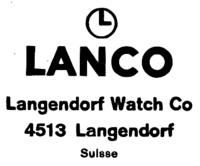
Lanco was the common brand of the Langendorf Watch Company, founded in 1873 by Johann Kottmann and run for generations by the Kottmann family before being absorbed into SSIH in 1965.
Johann Kottmann
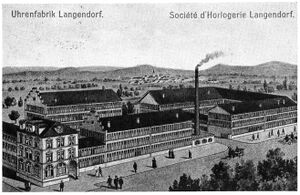
- See Also: Johann Kottmann
Uhrenfabrik Längendorf (the Langendorf Watch Company) was registered in 1877 but the company officially dates to 1873.
The origins of the firm date to the tobacco factory established by Dr. Auguste Kottmann in 1844. This firm included workshops in Solothurn, Burgdorf, and Balerna and was registered in 1860 as Tabak- & Cigarrenfabrik Solothurn by "Jean Kottmann", likely Johann Viktor Kottmann (1822-1881). Johann's obituary notes that he took over management of his father's tobacco company after his military service. Dr. Aug. Kottmann was notable in being among the first surgeons to successfully operate using a blood transfusion, which was called "nothing less than a resurrection" in 1875. The tobacco business was liquidated in 1886 by Dr. Aug. Kottmann and Karl Kottmann, likely his son (1844-1900).
In 1873, Johann Kottmann shifted his focus to watchmaking. He established a watchmaking business that year, registering it as Uhrenfabrik Langendorf in 1877. The firm took advantage of the rising demand for ebauches and availability of industrial machinery to produce ebauches for the many firms emerging in German-speaking Switzerland between Bienne and Grenchen. He faced many challenges, including the lack of skilled workers in the region. Kottmann began recruiting workers trained in the Swiss Jura, including French-speaking workers, and assisted them in establishing their homes in Langendorf.
The factor initially focused on production of ebauches for key-winding watches. It was successful enough to be transformed into a limited company in 1879 with share capital of 150,000 francs. This enabled the company to begin producing crown-winding movements as well, and to establish a village for workers houses.
In 1881, Johann Kottmann died of a stroke while on assignment for the military in Lucerne. By this time the growing factory employed 300 workers and produced over 800 ebauches per day.
Charles Kottmann
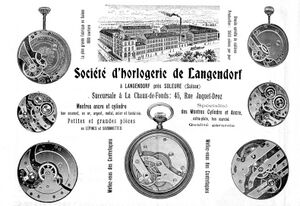
- See Also: Charles Kottmann
Following Johann Kottmann's death, his nephew Charles or Karl Kottmann (1844-1890) took over. One of his first acts was to reorganize the company as a stock corporation, which took effect on August 28, 1882, increasing share capital to 200,000 francs at the same time. He became director of the firm (listed as Charles Kottmann), with the board of directors composed of Major Zepfel (president), Leo Niggli (vice-president), J. Roth-Bloch, and Joseph Adler, cantonal councilor.
By 1886 the factory had grown so large that a new building was needed. The new factory would be a landmark in Langendorf for a century, located on a hill above the railroad station. It also provided additional space for worker housing to be built. In 1888 share capital was increased to 500,000 francs with additional investment and profits. The Langendorf factory quickly grew to be the largest watch movement factory in Switzerland, ahead of Omega in Bienne and Longines in Saint-Imier. It employed over 800 workers.
Charles Kottmann died suddenly on January 16, 1890. The board of directors promoted technical director Lucien Tièche to manage the business, and he faced many challenges, both from the industry and from workers.
Lucien Tièche
Lucien Tièche was a shopkeeper from Reconvilier who came to Langendorf in 1881 to work in the watch factory. Arriving on April 4, he swiftly rose to become a close associate of Charles Kottmann and joined the management committee of the factory by 1887 and was named technical director.
The first move taken on by Tièche was perhaps his most impactful. In 1893 the company began producing finished watches, and the factory rapidly brought component manufacturing in-house. Watch movements were produced on a moving assembly line, and dials and cases were produced in connected buildings as the factory grew. These initial watches were non-branded or used the "SHL" brand ("Société Horlogère Langendorf") but many more brands were soon registered to serve the export markets favored by the company.
Tièche was not loved or respected by the workers, especially after he took a hard line against them during the general strikes of 1894. He was called a "carpetbagger" and accused of mistreating workers in the (predominately socialist) newspapers. He responded to the demands of workers who had walked out by threatening to fire the rest of the unionized workers. It was reported the following year that Euseb Obrecht-Kessler of the Société d'Horlogerie de Granges, Peter Obrecht of Obrecht & Cie, and Adolf Schild-Hugi of Gebr. Schild & Co. were allowing Tièche to bear the brunt of the negotiations that they would later benefit from.
The strike was ultimately resolved, with Tièche remaining in charge of the Langendorf factory, but the damage to his reputation was severe. The call went up to bring the Kottmann family back to manage the factory, and the sons of Dr. Auguste Kottmann, younger brother of Charles Kottmann, were the ideal successors.
Following the arrival of Ernst and Rudolf Kottmann in 1901, Tièche left the firm to start his own watch handling business. Known as L. Tièche-Gammeter, it was founded in 1903 in Solothurn and continued to bear the brunt of worker animosity. The company was taken over in 1916 by Meyer & Stüdeli, which was founded by former Langendorf factory workers. The most lasting contribution of Tièche is the Roamer brand, which he registered in 1908 and would continue through the 20th century.
Rudolf and Ernst Kottmann

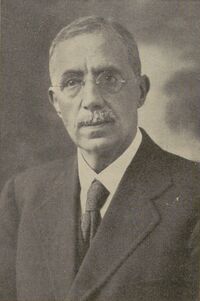
- See Also: Rudolf Kottmann and Ernst Kottmann
In 1901 Rudolf Kottmann (1878-1952) joined the firm. He rose to become chairman and managed it for decades along with his brother Ernst (1874-1944).
The Kottmann brothers continued Tièche's focus on mechanized production as well as his pivot to production of complete watches. Buyers of ebauches were no longer the priority, as the factory was able to use every movement they could produce in-house. In 1905 the Langendorf factory ceased supplying ebauches entirely, becoming a vertically-integrated manufacture. This decision, along with the continued manufacture of Roskopf watches, protected the company from the cartels that would control the production of ebauches (Ebauches SA) and watch components (ASUAG) in the 1920s and 1930s.
The company soon filed its first patents and registered additional brands. Seeking new markets, Langendorf was partner in the American Swiss Watch organization, which failed and was bankrupt in 1915. But the Langendorf factory continued to expand, employing 1500 workers and producing 3,000 watches daily at this point. After World War I production hit 750,000 watches per year.
A 1920 advertisement shows that the Langendorf factory was producing "Montres en tous genres, bon Courant, ancre et cylindre pour Dames et Hommes" ("watches of all types, current styles, with anchor and cylinder movements, for women and men"). This included upscale anchor watches using the "Lanco" brand and an 18 ligne alarm watch. The company also operated a department for precision screw making and cutting.
In 1924, Henri Buhler, editor of the Revue International de l'Horlogerie, visited the factory and wrote a long article about it. He was shocked by the size of the operation in Langendorf, noting that despite employing nearly 15,000 people the 9,520 square meter factory mostly housed machines operating autonomously. He also mentioned that, with production of 720,000 watches per year, the Langendorf factory alone accounted for about 5% of total Swiss watch exports.
Another joint venture in America, with Ptetzfelfder & Mills of New York, was more successful, even opening a branch in La Chaux-de-Fonds in 1925. And the firm began using the Lonville brand in the United States at this time, producing high-quality watches. By 1928 the company was also using the Lanco, Vera, Trovato, Langendorf, L.W.C., Méphisto, Verax, Scepter, Wengia, Solo, and other brand names. But a 1931 ad declares that the company was principally focused on the Lanco and Langendorf brands as well as Lancyl and Mephisto. A 1940 article clarifies that the Lanco brand is intended to be "the least expensive of brand watches" and includes offerings from 4.25 to 17.33 lignes. It also says that the factory is completely vertically integrated, apart from hairsprings, barrel springs, and hands.
In 1940 Langendorf appeared at the New York World's Fair, boasting the large factory and international success. The Lanco-Fon, an alarm model, was presented at the Basel Fair in 1949 and this became a well-known product, competing with the legendary Vulcain Cricket. It was noted to be much simpler to manufacture and operate, lacking an inner striking plate and with all functions controlled using the crown.
Hans and Guido Kottmann
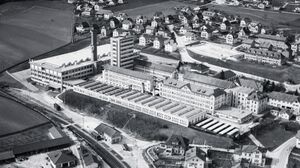
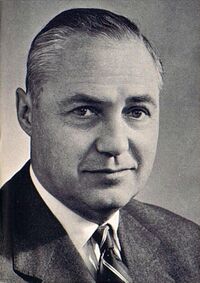
- See Also: Hans Kottmann and Guido Kottmann
The next generation of the Kottmann family began joining management of Lanco in the inter-war period. Hans Kottmann (1910-1964) joined the company in 1929 as sales manager. A pension fund was established in 1938 with his younger brother Guido Kottmann (1913-1965) named vice-president. Hans was named administrator of the factory and added to the board of directors in 1943 and named president of the new workers' crisis fund that year. Rudolf Kottmann was promoted to be a delegate on the board in 1945 as both Hans and Guido were added as members. This succession planning meant that the firm was able to continue operating smoothly filling Rudolf Kottmann's sudden death on August 9, 1952.
The company claimed to be the largest watch factory in Switzerland in 1959, building a new facility in Langendorf to employ 1500 employees and produce a wide variety of models. Lanco moved eagerly into the world of electric clocks, using a LIP movement.
By 1962 Paul Jenny served as managing director. The factory measured 40,000 square meters, with a 10 story tower looming above Langendorf. The factory was entirely vertically integrated, producing ebauches, dials, cases, assortments, spares, and more, and produced over 4,000 watches daily. Lanco created a line of uniform movements in the 1960s, including 5.5, 6.75, and 5.25 ligne movements for women and an 11.5 ligne movement with optional calendar for men.
The company's longstanding mechanized production line lead the firm to produce such machines for sale in the 1960s. The "Lanco Economic" production system distributed parts on the assembly line and would become the primary focus for the company.
SSIH
Hans and Guido Kottmann were approached by both SSIH and ETA by 1964 about an acquisition, with both groups seeking to increase production. Following Hans' sudden death in a traffic accident on December 10, this talk became more serious. And it intensified further when Guido died of a heart attack on June 15. It was clear that the time had come for Lanco to join one of the major Swiss holding companies.
The board decided to take the SSIH offer. Lanco became the mass-market leader below Tissot and Omega. This was part of an effort by SSIH to conquer the mid-range and low-end watch markets, and to increase production over 1 million watches annually. This was successful thanks to Lanco, which brought the group to 1.7 million watches by 1970.
But the crisis of the 1970s proved a serious challenge to this goal. SSIH acquired Economic Swiss Time Holding in 1971, and a rationalization of production was urgently needed. Omega and Tissot prevailed, thanks to their privileged position in the holding company, and Lanco was forced to stop producing watch movements. 25% of the workforce was dismissed in 1972 as the firm focused on watch assembly, manufacture of dials, and production of the Lanco Economic assembly system.
In the 1970s, Lanco used Tissot movements, including the Astrolon, a watch that used plastic wheels. And Lanco's brand was used on mass produced quartz and digital LED watches. Eventually the large factory in Langendorf was superfluous. Management of the Lanco Economic division purchased it in 1981 to form a separate company. Following the merger of SSIH and ASUAG in 1983 the Lanco brand was discontinued.
The main Lanco factory, with the 10-story tower, is now a large Migros supermarket, while the rest of the factory was demolished.
Timeline
- 1877 - Uhrenfabrik Längendorf is established by Kottmann & Meyer
- 1882, August 28 - At an official meeting the Uhrenfabrik Längendorf becomes a public limited company; share capital is 200,000 francs, with a further 100,000 francs envisaged; director of the company is C. Kottmann; members of the board of directors are Major Zepfel as president, Leo Niggli as vice-president, J. Roth-Bloch, and Joseph Adler; business premises is building no. 49 and 49 B in Langendorf
- 1888, March 8 - Share capital is 300,000 francs; 200 new shares of 1000 francs are authorized; the Board of Directors authorizes the issuance of bonds to raise capital
- 1890, January 20 - Following the death of director Carl Kottmann, Lucien Tièche is given authority
- 1890, February 14 - Lucien Tièche is officially made director
- 1891, November 26 - Albert Frölicher, Hermann Strausak, and Arnold Sauser are given power of attorney
- 1894, February 31 - Arnold Sauser has resigned; Albert Fröhlicher and Hermann Strausak remain in charge
- 1896, March 17 - The company is officially renamed Uhrenfabrik Langendorf (rather than Längendorf)
- 1897, November 4 - The collective power of Hermann Strausak and Albert Froelicher is replaced by individual authority for Hermann Strausak; Albert Froelicher's power is collective with Chairman of the Board of Directors, Dr. A. Kottmann
- 1938, December 22 - A pension fund (Fürsorgefonds der Uhrenfabrik Langendorf) is established; Hans Wyss is president, Guido Kottmann is vice president, Ernst Russwil is secretary, and Walter Rölli, Hermann Meier-Noth are members
- 1943, March - The board of directors makes Hans Kottmann an authorized signatory for the company
- 1943, December 2 - A crisis fund (Krisenwohlfahrtsfonds der Uhrenfabrik Langendorf) is established; Rudolf Kottmann is president, Guido Kottmann is treasurer, and Hans Wyss is a member
- 1945, March - Rudolf Kottmann is promoted to administrator and board member; Hans Kottmann and Guido Kottmann are appointed directors
- 1948, March 9 - The company's statutes are completely revised; "The purpose of the company is: a) the manufacture of watch movements, pocket, and wristwatches, as well as production tools and trade in such; b) the operation of all auxiliary industries and related industries and the sale of their products; c) the construction or acquisition, lease, and operation of factories and plants that serve the aforementioned purposes; d) the company may also extend its activities to other areas related to its purpose and participate in enterprises that fall within its line of business."; Hans Kottmann and Guido Kottmann are added to the board of directors; Fritz Ziegler is removed
- 1952, January - Hans Wyss resigns from both the pension and crisis funds, replaced by Guido Kottmann at the former and Hans Kottmann at the latter
- 1952, October - Following the death of Rudolf Kottmann, Guido Kottmann becomes president of the crisis fund
- 1961, January - Hans Kottmann and Guido Kottmann are promoted from members to delegates of the Board of Directors; Paul Gustav Jenny, previously sales director, was elected director; Ernst Stauber, previously authorized signatory, was elected as operations director; new authorized signators are Urs Witmer, Fritz Gugelmann, Hans Kurz, and Edwin Jakob.
- 1965, January - Following the sudden death of Hans Kottmann in a traffic accident Dr. Wilhelm Pfaehler and Fritz Schürch are elected to the board; Dr. Hans Spillmann is President of the Board
- 1965, August - Following the takeover by SSIH and the death of Guido Kottmann, Hans Marti is appointed administrative director and Willy Blindenbacher is appointed financial director; Urs Witmer and Edwin Jakob are removed
- 1966, October - The pension and crisis funds are reorganized, with Guido Kottmann (deceased) and Dr. Hans J. Spillmann removed and replaced by Hans Flückiger, President, Charles L. Brandt, Vice-President, and Willy Blindenbacher; Hans Marti remains secretary